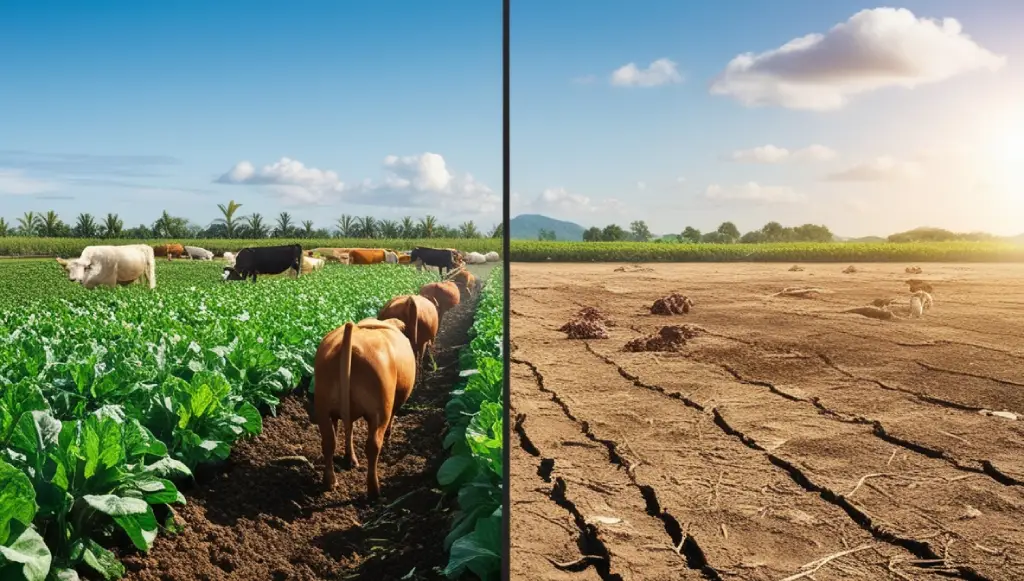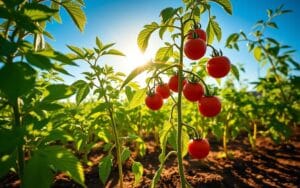Learn how climate change affects global food security, from changing weather patterns to food price volatility. Discover effective mitigation strategies.
Can you imagine a world where food becomes scarce and expensive, making it difficult for many to access daily meals? Unfortunately, this could become a reality as climate change continues to alter the planet’s delicate ecosystem.
How climate change affects global food security is a serious concern that threatens the stability of food supplies worldwide.
As temperatures rise, weather patterns shift, and extreme events become more frequent, agriculture—the backbone of global food production—is under threat.
In this article, we will explore the various ways climate change is disrupting food security, from soil degradation to the spread of pests and diseases, and highlight mitigation strategies that can help build resilience.
Let’s dive in and see how our changing climate impacts what we eat every day, and what can be done about it!
Table of Contents
ToggleHow Climate Change Affects Global Food Security
Climate change has a profound impact on the environment, which in turn affects global food security. Let’s delve into the specific aspects that illustrate how climate change affects global food security, providing insights into the various dimensions of this issue.
1. Changing Weather Patterns
Weather patterns are crucial for agricultural production. Climate change alters these patterns, leading to unpredictable seasons.
Regions that once had stable climates are now facing irregular rainfall, prolonged droughts, and unexpected frosts. Crops such as rice, wheat, and corn are highly dependent on predictable weather to grow.
With the current changes, farmers struggle to plan their planting and harvesting schedules. This unpredictability means lower crop yields, affecting food availability.
For instance, in Southeast Asia, unpredictable monsoon patterns have made it harder for rice farmers to produce consistent crops, leading to a reduced supply. The more erratic the weather, the more challenging it becomes for farmers to adapt, impacting food security globally.
2. Increased Frequency of Extreme Weather Events

The frequency and intensity of extreme weather events—such as hurricanes, floods, and heatwaves—have increased due to climate change.
These events can destroy crops, reduce soil quality, and wipe out livestock. The United Nations Food and Agriculture Organization (FAO) reports that such disasters are responsible for major agricultural losses worldwide.
Floods can ruin fertile lands, while droughts can lead to water scarcity, affecting irrigation. For example, a severe drought in California in recent years led to massive losses in fruit and vegetable production, raising food prices and affecting supply chains across the United States.
This illustrates how climate change affects global food security by making food production less predictable and reliable.
3. Soil Degradation and Desertification
Soil health is critical for agriculture. However, climate change contributes to soil degradation and desertification, reducing the land’s ability to sustain crops.
Higher temperatures accelerate the evaporation of soil moisture, making it more difficult for plants to absorb the water they need.
Furthermore, poor farming practices combined with climate-induced factors can lead to the loss of fertile topsoil, reducing the land’s productivity.
In regions like sub-Saharan Africa, increasing desertification has made it challenging for farmers to cultivate crops, resulting in lower food production.
Without healthy soil, achieving sustainable agriculture becomes almost impossible, showing another facet of how climate change affects global food security.
4. Impact on Livestock and Fisheries
Livestock and fisheries are not immune to the effects of climate change. Rising temperatures, water shortages, and changing oceanic conditions have a direct impact on animal health and fish stocks.
Livestock requires water and pasture; however, prolonged droughts can reduce the availability of both, leading to malnutrition and disease outbreaks. Similarly, ocean warming affects fish populations, altering migration patterns and reducing available stocks for fishing.
The decline in fish populations affects countries that heavily rely on fish as a primary protein source, such as Japan and Indonesia.
This demonstrates how climate change affects global food security by disrupting both terrestrial and marine food supplies.
5. Pest and Disease Spread
With warmer temperatures and shifting climates, pests and diseases are spreading to new regions. Crops that were once safe from certain pests now face new threats, as milder winters fail to kill off invasive species.
For example, locust swarms have been devastating parts of East Africa, a situation made worse by changing climate conditions that favor their breeding.
Additionally, the spread of plant diseases, such as wheat rust and rice blast, threatens global food supplies. This spread is accelerated by warm, wet conditions that allow pathogens to thrive.
Thus, how climate change affects global food security extends to increased risks from pests and diseases, making crop protection more challenging.
6. Impact on Agricultural Practices
Agricultural practices have had to adapt to the changing climate, but it’s not always easy. Traditional farming methods might not be suitable anymore as crops fail to grow in their usual environments.
Farmers are now required to employ new techniques, such as crop rotation, soil management, and irrigation adjustments, which may be costly and difficult to implement, especially in low-income regions.
In countries where agriculture is a major part of the economy, the shift to new practices can be slow, leading to reduced agricultural output.
Therefore, how climate change affects global food security also involves the transformation of farming practices, posing a challenge to farmers globally.
7. Food Supply Chain Disruption
Food doesn’t just go from the farm to your plate; it undergoes a series of processes—harvesting, transportation, storage, and distribution.
Climate change disrupts these processes at multiple levels. Extreme weather can damage infrastructure, delay transportation, and spoil stored food.
For instance, hurricanes in the Gulf Coast of the United States have disrupted food supply chains by damaging ports and highways, leading to food shortages.
Such disruptions mean that even if there is enough food produced, getting it to those who need it becomes a problem, further illustrating how climate change affects global food security.
8. Food Price Volatility
When food production is affected, prices fluctuate. Climate change leads to reduced crop yields, which in turn raises prices due to limited supply.
People in developing countries, where a large portion of income is spent on food, are hit the hardest by these price changes. For example, a drought in Brazil can impact coffee prices worldwide, illustrating the global nature of food security.
Food price volatility affects everyone, but it disproportionately impacts those in poverty, demonstrating a critical aspect of how climate change affects global food security.
Mitigation and Adaptation Strategies
Mitigation and adaptation are essential in addressing the challenges posed by climate change to global food security. Here are some strategies:
- Sustainable Farming Practices: Utilizing crop rotation, water-efficient irrigation, and organic fertilizers can help preserve soil health and water resources.
- Climate-Resilient Crops: Developing and planting crops that are more tolerant to extreme weather conditions can safeguard food production.
- Efficient Supply Chains: Strengthening infrastructure to withstand extreme weather can reduce disruptions in food supply chains.
- Education and Training for Farmers: Providing knowledge and tools to farmers on sustainable agriculture can help them adapt to climate changes effectively.
Conclusion
Climate change is one of the biggest threats to global food security. It disrupts every stage of food production, from planting to distribution, making it more difficult to ensure a stable supply of food worldwide.
By understanding how climate change affects global food security, we can take proactive steps to adapt and mitigate these impacts. However, solving this issue requires collective global effort, policy changes, and sustainable practices.
Want to learn more about protecting our planet and food supply? Visit earthguardiansonline.com for insights and guidance on how you can make a difference.
FAQ
What is food security, and why is it important?
Food security means having reliable access to a sufficient quantity of affordable, nutritious food. It’s essential for health, stability, and economic prosperity.
How does climate change threaten food security?
Climate change affects food security by disrupting weather patterns, increasing extreme events, spreading pests, and altering growing conditions.
Can sustainable farming help mitigate the effects of climate change on food security?
Yes, sustainable farming practices can help conserve resources, improve soil health, and make crops more resilient to climate changes.
What role can consumers play in supporting global food security?
Consumers can support sustainable food practices, reduce food waste, and advocate for policies that address climate change and its impact on agriculture.









